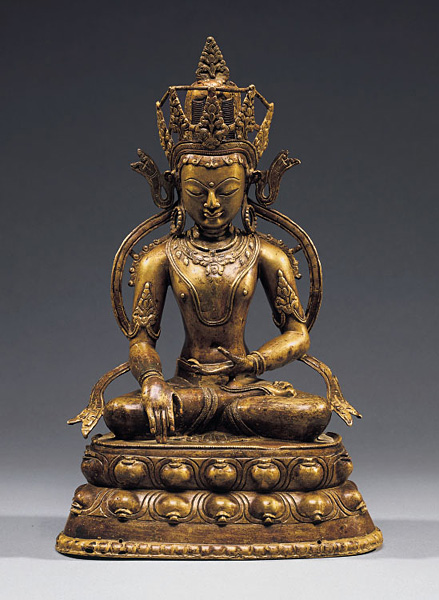|

Aksobhya is one of the five transcendental Buddhas, the cosmic Dhyani-Buddhas who are regarded as the spiritual sons of the Adi- Buddha in human form (the embodiment of the five cosmic elements). Aksobhya is considered to help mankind in overcoming the affliction of anger, one of the most potent and dangerous obstacles for human beings in order to attain enlightenment; he represents the transformation of anger into absolute perfection and wisdom. The second cosmic Buddha is the embodiment of consciousness and represents the winter season, the faculty of hearing and the elements of ether and sound. �The lord of the east� has the same appearance and meaning as Sakyamuni (the historical Buddha) in his guise as the conqueror of the demon Mara.
Buddha Aksobhya is seated in vajrasana (legs crossed) in the diamond or interlocking lotus position on a double lotusthrone. His right hand is extended down in bhumisparsa mudra, the earth-witness gesture. His left hand rests in his lap in dhyani mudra, the gesture of contemplation. Aksobhya's hair is piled up in a high coiffure, some locks of hair are depicted on his shoulders. The symbol of his ultimate wisdom is represented by the ushnisa on top of his head. The Buddha wears an urna (sign of illumination) on his forehead and is dressed in the garments of a Bodhisattva; adorned with a three leaf crown, flowers above his ears, circular earrings, three necklaces, bracelets, anklets and ornaments. Other features are the Buddhist wheel of the law which is depicted on his hands and feet, the elongated earlobes denoting royalty, and a circular scarf circling around the body.
This Buddha is a classic example of an early central-Tibetan type. The characteristics which help to define this style are the exquisite light and well cast alloy which comprises of a number of fine metals, the large and pronounced lotusleaves and pearls depicted on the throne, the typical tiara with connecting struts, the shape of the jewellery, the large circular earrings with thick pearl-motif, the open folded flowers above the ears, the finely folded dress in front of his legs, the circular scarf around the body which is folded at the extremities and the engraved design with triangles and catfoot-prints. The bronze shows similarity with other early temple examples in the way that it is made to be seen frontally, the back being not finished with details. In addition it has connecting struts (crown and scarf), and is executed with silver and copper inlay.
As exemplified by the mudra of his right hand, the cosmic Buddha is depicted in a superbly well balanced form with natural volumes. The inspired and meditative character is revealed by fine sensitive modelling, well articulated details and natural positioning of all features, including the finely curved fingers and feet, enhancing the confidence of his inner will. The powerful movement of the circular scarf placed around Buddha's body, and the subtle tension of his upright body, increase the god's lively expression. With a majesty and a softness, a beauty and a power, this image of Aksobhya reflects the rarest quality.
|

